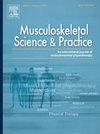单部位疼痛与多部位疼痛患者运动和教育后结果的变化;对31276例膝关节或髋关节骨关节炎患者的分析
IF 2.2
3区 医学
Q1 REHABILITATION
引用次数: 0
摘要
目的骨关节炎多部位疼痛(MSP)定义为≥2个部位疼痛,与单部位疼痛(SSP)相比,健康状况较差。我们比较了在8周的教育和锻炼计划(GLA:D®)后,SSP和MSP患者在3个月和12个月时健康结果的变化。方法纳入GLA:D®(2014-2021)的膝/髋OA患者根据疼痛部位数量分为4组:0-1个部位(SSP)、2个部位(MSP2)、3-4个部位(MSP3-4)、≥5个部位(MSP5+)。使用协方差分析、广义估计方程和应答者分析比较各组在3个月和12个月时疼痛、生活质量(QoL)和身体功能的变化。结果31276名参与者中约90%有≥2个疼痛部位。在12个月时,与SSP相比,所有MSP组的疼痛严重程度平均降低了- 3.79 (95% CI -4.90至- 2.68)。与SSP相比,MSP2组和MSP3-4组的生活质量提高了1-2分,而40米步行或30秒站立的变化没有差异。与SSP相比,所有MSP组在3个月(43 - 44%比36%)和12个月(44 - 47%比37%)时疼痛应答者的比例更高。在12个月时,MSP2组的生活质量应答者比SSP组的应答者比例更高(36%比32%);MSP3-4组与MSP5+组在3个月时的身体功能差异(56% vs 52%)。结论:虽然经过8周的教育和锻炼计划后,MSP患者的疼痛和生活质量的改善比SSP患者更大,但身体功能没有改善,但组间差异在临床上并不重要。本文章由计算机程序翻译,如有差异,请以英文原文为准。
Changes in outcomes following exercise and education in individuals with single-site pain versus multi-site pain; an analysis of 31,276 patients with knee or hip osteoarthritis
Objective
Multisite pain (MSP) in osteoarthritis defined as pain in ≥2 sites is associated with poorer health than single-site pain (SSP). We compared changes in health outcomes at 3- and 12 months in those with SSP versus MSP following an 8-week education and exercise programme (GLA:D®).
Methods
Participants with knee/hip OA enrolled in GLA:D® (2014–2021) were categorised into four groups based on number of pain sites: 0–1 sites (SSP), 2 sites (MSP2), 3–4 sites (MSP3-4), ≥5 sites (MSP5+). Changes in pain, Quality of Life (QoL) and physical function were compared across groups at 3- and 12-months using Analysis of Covariance, Generalised Estimating Equations and responder analyses.
Results
Approximately 90 % of 31,276 participants had ≥2 pain sites. At 12 months, pain severity reduced by a mean of −3.79 (95 % CI -4.90 to −2.68) in all MSP groups versus SSP. QoL improved by 1–2 points in MSP2 and MSP3-4 groups compared to SSP, with no difference in change in 40m walk or 30-second chair-stand. The proportion of pain responders was higher in all MSP groups compared to SSP at 3 (43–44 % vs 36 %) and 12 months (44–47 % vs 37 %). There was a greater proportion of responders in QoL in MSP2 versus SSP at 12 months (36 % vs 32 %); and in MSP3-4 versus MSP5+ at 3 months in physical function (56 % vs 52 %).
Conclusions
Whilst improvements in pain and QoL, but not physical function, were greater in those with MSP compared to SSP following an 8-week education and exercise programme, between-group differences were not clinically important.
求助全文
通过发布文献求助,成功后即可免费获取论文全文。
去求助
来源期刊

Musculoskeletal Science and Practice
Health Professions-Physical Therapy, Sports Therapy and Rehabilitation
CiteScore
4.10
自引率
8.70%
发文量
152
审稿时长
48 days
期刊介绍:
Musculoskeletal Science & Practice, international journal of musculoskeletal physiotherapy, is a peer-reviewed international journal (previously Manual Therapy), publishing high quality original research, review and Masterclass articles that contribute to improving the clinical understanding of appropriate care processes for musculoskeletal disorders. The journal publishes articles that influence or add to the body of evidence on diagnostic and therapeutic processes, patient centered care, guidelines for musculoskeletal therapeutics and theoretical models that support developments in assessment, diagnosis, clinical reasoning and interventions.
 求助内容:
求助内容: 应助结果提醒方式:
应助结果提醒方式:


